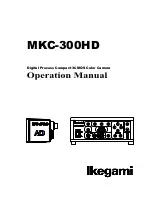
This manual
is intended for administrators and users of the WebView MPEG4/JPEG
Dual Mode Network IP Camera
[Model MNC-L200/MNC-W200]
, and is applicable for
software release 1.4.0 and later. It includes instructions for using and managing the WebView
MPEG4/JPEG Dual Mode Network IP Camera on your network. Previous experience of
networking will be of use when using this product. Some knowledge of UNIX or Linux-based
systems may also be beneficial, for developing shell scripts and applications. Later versions of
this document will be posted to
www.micro-web.co.kr
, as required.
FCC Statement
This equipment generates, uses and can radiate radio frequency energy and, if not installed and used in
accordance with the instructions, may cause harmful interference to radio communications. However,
there is no guarantee that interference will not occur in a particular installation. If this equipment does
cause harmful interference to radio or television reception, which can be determined by turning the
equipment off and on, the user is encouraged to try to correct the interference by one or more of the
following measures;
-
Re-orient or relocate the receiving antenna.
-
Increase the separation between the equipment and receiver.
-
Connect the equipment to an outlet on a different circuit to the receiver.
-
Consult your dealer or an experienced radio/TV technician for help.
-
Shielded (STP) network cables must be used with this unit to ensure compliance with EMC
standards.
This equipment has been tested and found to comply with the limits for Part 15 of FCC rules, which are
designed to provide reasonable protection against such interference when operated in a commercial
environment. Operation of this equipment in a residential area is likely to cause interference, in which
case the user at his/her own expense will be required to take whatever measures may be required to
correct the interference.
FCC Caution
: Any changes or modifications not expressly approved by the party responsible for
compliance could void the user’s authority to operate this equipment.
This device complies with Part 15 of FCC Rules. Operation of the device is subject to the following two
conditions: (1) This device may not cause harmful interference, and (2) This device must accept any
interference that may cause undesired operation.


































